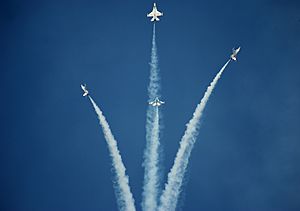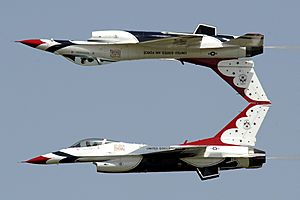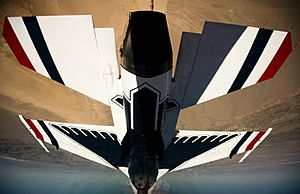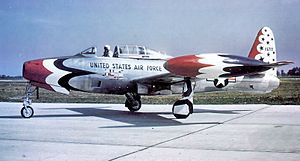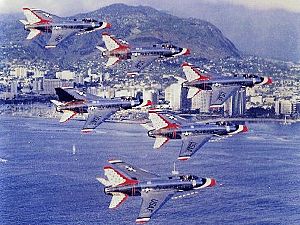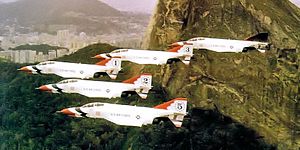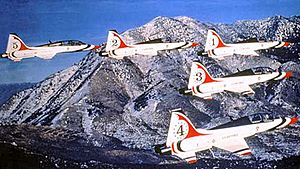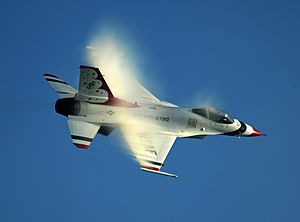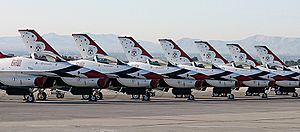United States Air Force Thunderbirds facts for kids
Quick facts for kids ThunderbirdsUSAF Air Demonstration Squadron |
|
|---|---|

Diamond formation at the 2009 Dayton Air Show
|
|
| Active | 25 May 1953 – present (as air demonstration squadron) 13 June 1917 – 1 February 1963 (as operational squadron) |
| Country | |
| Branch | |
| Role | Aerobatic display team |
| Size | 12 officers 120 enlisted support personnel |
| Part of | Air Combat Command |
| Garrison/HQ | Nellis Air Force Base Las Vegas, Nevada |
| Colors | Red, White and Blue |
| Engagements | World War I World War II (Pacific Theater) Korean War |
| Insignia | |
| Identification symbol |
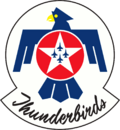 |
| Aircraft flown | |
| Fighter | six F-16C Fighting Falcons two F-16D Fighting Falcons |
The USAF Air Demonstration Squadron, known as the Thunderbirds, is the amazing air show team of the United States Air Force (USAF). They are based at Nellis Air Force Base in Nevada. The Thunderbirds started in 1953. They are the third-oldest official flying aerobatic team in the world. Only France's Patrouille de France (1931) and the U.S. Navy's Blue Angels (1946) are older.
The Thunderbirds travel all over the United States and the world. They perform incredible formation flying and solo stunts in their special planes. Their name comes from a legendary bird in Native American stories.
Contents
What are the Thunderbirds?
The Thunderbirds Squadron is a special unit in the Air Force. It doesn't have a number like most squadrons. Its history goes way back to June 13, 1917. That's when the 30th Aero Squadron was formed in Texas.
Pilots usually stay with the team for two years. Other team members stay for three to four years. About half the team changes each year. This helps keep a good mix of new and experienced people. The Thunderbirds perform up to 88 air shows every year. They are also part of the Air Force's combat force. This means they could join a fighter unit if needed. Since 1974, they have been part of the 57th Wing at Nellis Air Force Base. Over 300 million people have watched them fly since 1953.
The F-16 Fighting Falcon: The Thunderbirds' Jet
The Thunderbirds fly the F-16C Fighting Falcon for their shows. They also use two F-16D planes for training new pilots. The F-16 has been their main show plane since 1983.
Before 1983, the team flew T-38 Talon jets. In 1982, four pilots died in a crash during training. This sad event was called the "Diamond Crash." After that, the team switched to the F-16A. They spent 1982 training with the new planes. The F-16 was already being considered before the accident. The Air Force brought back former Thunderbird pilots to help rebuild the team. They started with two planes and slowly added more. By June 1982, Major Jim Latham led the F-16 Thunderbirds.
The team still uses the F-16 today. They upgraded from the F-16A to the F-16C in 1992. There are only a few small changes to a Thunderbird F-16. They remove the cannon and add a system to make smoke for the shows. They also paint the planes in the Thunderbirds' bright red, white, and blue colors. These changes are done at a special maintenance center. Otherwise, the planes are standard F-16s. They can be sent back to regular Air Force units if needed.
Different F-16 Models
- F-16A/B Fighting Falcon: The Thunderbirds used these planes from 1983 to 1991. They were some of the last Air Force units to fly the older F-16A models. The F-16B was a two-seat version used for training.
- F-16C/D Fighting Falcon (Block 32): These planes were built in 1986 and 1987. The Thunderbirds flew them from 1992 to 2008. They were some of the oldest F-16s still flying in the Air Force when they retired.
- F-16C/D Fighting Falcon (Block 52): In 2009, the Thunderbirds got newer F-16s. These Block 52 planes have better electronics. They also have a more powerful engine. This engine gives them more thrust, allowing for heavier takeoffs and maneuvers.
Support Aircraft
The Thunderbirds also use a Boeing C-17 Globemaster III plane. This large plane helps transport their equipment and support staff to air shows.
The Amazing Air Show Routine
The Thunderbirds' show starts with the team leader saying, "Thunderbirds, let's run 'em up!" The crowd hears this over the loudspeakers.
Diamond Formation Takeoff
The first four Thunderbirds, numbers 1 through 4, take off together. The fourth plane quickly moves into position behind the leader. This creates their famous Diamond formation. With their powerful F-16s, the Diamond can climb straight up into their first move, the Diamond Loop.
Solo Pilot Stunts
Next, Thunderbird 5 takes off. It performs a smooth, low-altitude roll. Then, Thunderbird 6 takes off. It climbs almost straight up, rolls over, and dives back towards the center of the show. It pulls up just above the runway and exits in the other direction.
The show switches between moves by the four-plane Diamond and the two solo planes. They use eight different formations, including the Diamond, Delta, and Arrowhead. In the Arrowhead, the planes fly very close, sometimes only 18 inches apart! They do loops and rolls, changing from one formation to another. All these moves are done at speeds of 450 to 500 miles per hour.
The solo pilots fly even faster, usually between 500 and 700 miles per hour. They show off how amazing their F-16s are. They do fast passes, slow passes, and tight turns. Sometimes both solo planes fly together. They might do opposing passes, flying very close to each other. Or they might do mirror formations, flying back-to-back or belly-to-belly. In mirror formations, Thunderbird 5 flies upside down. Its number 5 is even painted upside down on the plane! The pilot of Thunderbird 5 also has their number sewn upside down on their flight suit.
The Grand Finale
Near the end of the show, the Diamond formation pulls straight up into the sky. They perform their famous "Bomb Burst." All four planes break away in different directions. One solo plane flies straight up through the middle, doing rolls for three miles into the sky. To finish the show, all six planes join together in the Delta formation.
The Thunderbirds also fly over the United States Air Force Academy graduation ceremony every year. They fly over Falcon Stadium exactly when the graduating cadets throw their hats into the air.
Thunderbirds History
The USAF Air Demonstration Squadron, the Thunderbirds, has a long and interesting history. On September 19, 1985, their history was officially combined with the 30th Bombardment Squadron. This older unit started way back on June 13, 1917.
The 30th Bombardment Squadron served in World War I in France. They trained fighter pilots for combat. During World War II, they were in the Philippines when Japan attacked in 1941. Some members fought as soldiers and were captured. They had to endure the Bataan Death March. The squadron later reformed and attacked Japan with B-29 Superfortress planes. They earned nine special awards in World War II. In the Korean War, the 30th also attacked targets in North Korea. Today, the Thunderbirds carry on the proud history of the 30th Squadron.
Early Days: F-84 Thunderjet and Thunderstreak
The Thunderbirds officially started on May 25, 1953, at Luke Air Force Base in Arizona. Their first leader was Major Richard C. Catledge. The first plane they used was the F-84G Thunderjet. Since the Thunderjet was a single-seat plane, a two-seat T-33 Shooting Star was used for the narrator and for VIP rides.
In 1954, the Thunderbirds performed their first shows outside the U.S. They toured South and Central America. In 1955, they switched to the F-84F Thunderstreak. This plane had swept wings. They also got their first support plane, a C-119 Flying Boxcar.
Supersonic Era: F-100 Super Sabre
In June 1956, the Thunderbirds changed planes again, this time to the F-100C Super Sabre. This plane could fly faster than the speed of sound! With this change, they moved their home base to Nellis Air Force Base in Nevada. This made it easier to maintain the F-100s. Their shows changed too. They focused on fast, low flyovers and impressive takeoffs. For a while, they even created sonic booms, but this was later stopped.
In 1962, they started doing dual solo routines. In 1963, the Thunderbirds went on their first European tour. In 1964, they briefly used the F-105 Thunderchief. But after a crash, they quickly switched back to the F-100D Super Sabre. They used the F-100D until 1968.
The Powerful F-4 Phantom II
By 1967, the Thunderbirds had performed 1,000 shows! In 1969, they upgraded to the powerful F-4E Phantom. They flew this jet until 1973. This was the only time the Thunderbirds flew jets similar to the Blue Angels. The F-4 was a standard fighter for both military branches then.
The Fuel-Efficient T-38 Talon
Because of a fuel shortage in the early 1970s, the team had to reduce their shows. In 1974, they switched to the more fuel-efficient T-38 Talon. Five T-38s used the same amount of fuel as just one F-4 Phantom. This change also meant the black tail on the No. 4 slot plane was no longer needed.
In 1982, the Thunderbirds had a terrible accident during training. Four pilots died when their planes crashed. The Air Force found that a mechanical problem with the lead plane's controls caused the crash. The other pilots were following the lead plane too closely.
Modern Era: F-16 Fighting Falcon
After the 1982 crash, the team stopped flying for six months. They reviewed their program and then started again in 1983 with the General Dynamics F-16 Fighting Falcon. They upgraded to the F-16C in 1992.
In 1986, the Thunderbirds flew over the Statue of Liberty for its re-dedication. In 1987, they made history by performing in China, the first American military team to do so in a communist country.
They performed their 3,000th air show in 1990. In 1991, they toured Europe, visiting Switzerland, Poland, and Hungary. They went abroad again in 1996 to Romania, Bulgaria, and Slovenia. Also in 1996, they were part of the opening ceremonies for the 1996 Summer Olympics in Atlanta.
In 1997, the U.S. Postal Service honored the Air Force's 50th anniversary with a special stamp featuring the Thunderbirds.
In June 2005, Major Nicole Malachowski became the first female pilot on the team. In 2007, Captain Samantha Weeks became the second female pilot.
In 2007, the Thunderbirds went on a goodwill tour in Europe. They performed their first show ever in Ireland. Over 100,000 people watched, despite bad weather. They also visited Poland, Romania, Bulgaria, Italy, France, and England. In England, they were part of the Royal International Air Tattoo, the world's largest air show. The team also met with children in need across Europe.
In November 2007, Las Vegas and Nellis Air Force Base celebrated the U.S. Air Force's 60th anniversary.
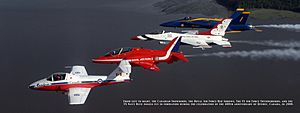
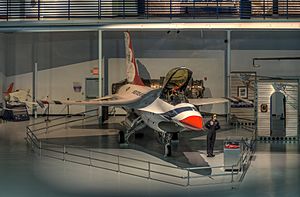
In 2008, the Thunderbirds stayed in North America. They performed in the U.S. and Canada. They flew over Quebec City for its 400th anniversary. They joined Canada's Snowbirds, the UK's Red Arrows, and the U.S. Navy's Blue Angels for this special flight.
In 2009, the Thunderbirds welcomed their first pilot from the Air National Guard, Lt. Col. Derek Routt. Major Sean Gustafson, the first Reserve pilot, also joined the team.
The 2009 Far East Tour took the team to places like Hawaii, Australia, Malaysia, Guam, Thailand, Japan, and South Korea. Over 1.2 million people saw their shows in person. Millions more watched on TV. The team also spent time with over five hundred children with special needs and orphans.
In 2013, the entire flying season was canceled due to government budget cuts. Team members still made appearances locally. Performances started again in 2014.
Historical Demonstration Aircraft
- Republic F-84G Thunderjet: Used from 1953 to 1954.
- Republic F-84F Thunderstreak: Used from 1955 to 1956. It had smoke tanks and red, white, and blue parachutes.
- North American F-100C Super Sabre: Used from 1956 to 1963. This made them the first supersonic air show team.
- Republic F-105B Thunderchief: Only used for six shows in 1964 due to safety concerns.
- North American F-100D Super Sabre: Used from 1964 to 1968.
- McDonnell F-4E Phantom II: Used from 1969 to 1973. This jet needed special paint to look good at high speeds.
- Northrop T-38 Talon: Used from 1974 to 1981. This supersonic trainer was chosen because it used less fuel.
Other Air Force Demo Teams
The first Air Force jet demo team was the "Acrojets" in 1949. They flew F-80Cs. Another team, the "Skyblazers", represented the U.S. Air Forces in Europe from the late 1940s to the 1950s. They flew different jets like the F-80B, F-84E, F-86F, and F-100C. Two of the original Skyblazer pilots, twin brothers C.A. "Bill" and C.C. "Buck" Pattillo, later joined the first Thunderbird team. The Skyblazers usually performed only in Europe. They were disbanded in 1962.
The "Four Horsemen of the Apocalypse" were a team of four C-130 pilots. They were an official demo team from 1957 to 1960.
Thunderbirds Museum
There is a Thunderbirds Museum at Nellis Air Force Base. It shows the history of the team. It even has a full-size F-16 plane painted in Thunderbird colors on display outside.
Notable Members of the Thunderbirds
Here are some famous people who have been part of the Thunderbirds:
- Sam Johnson: An American politician and military pilot.
- Nicole Malachowski: The first female pilot to join the Thunderbirds.
- Merrill McPeak: An Air Force General and pilot.
- Michelle Curran: An Air Force pilot and the fifth female Thunderbird pilot.
Images for kids
-
An F-100D on display at the National Museum of the United States Air Force
See also
 In Spanish: USAF Thunderbirds para niños
In Spanish: USAF Thunderbirds para niños



